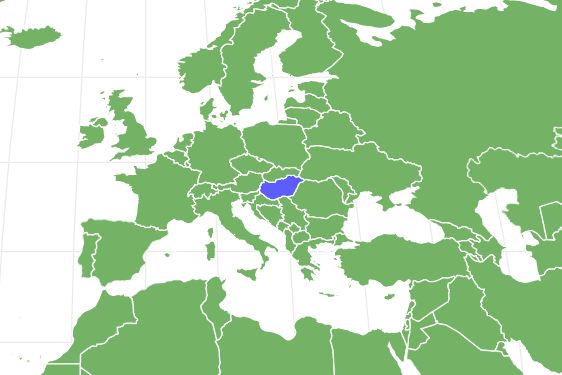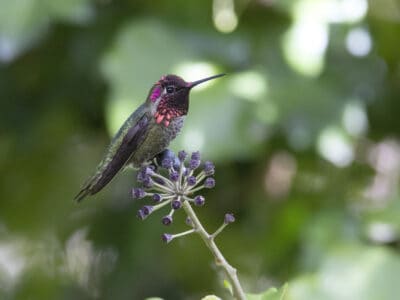Puli
Canis lupus
Advertisement
Puli Scientific Classification
- Kingdom
- Animalia
- Phylum
- Chordata
- Class
- Mammalia
- Order
- Carnivora
- Family
- Canidae
- Genus
- Canis
- Scientific Name
- Canis lupus
Read our Complete Guide to Classification of Animals.
Puli Conservation Status
Puli Facts
The puli is an unmistakable dog breed, covered from snout to tail with wild, naturally occurring cords. These compact dogs were bred to partner with humans as speedy, powerful livestock herders, making them faithful companions and highly intelligent learners.
Historians believe pulik – the plural form of puli – were brought to Europe by Asian nomadic tribes to guard large flocks of sheep in Hungarian plainlands. While they’re used less often as herders today, their instinct remains strong — pulik herd just about anything, from other dogs and birds to human toddlers.
Puli dogs’ natural dreadlocks are instantly recognizable. They are wooly and dense, and nearly entirely waterproof, bred to protect them from brutal European winters. Whether corded or brushed through, puli coats require detailed, devoted attention. With proper care and lots of leadership, the puli makes a fun-loving, agile companion that’s happy to join on any adventure.
Read on to learn more about pulik and what to know before considering adopting a dog.
The name Puli means “drover” or “destroyer.” These dogs almost went extinct due to supply shortages during World War II. Thankfully, they’ve returned in numbers and popularity.
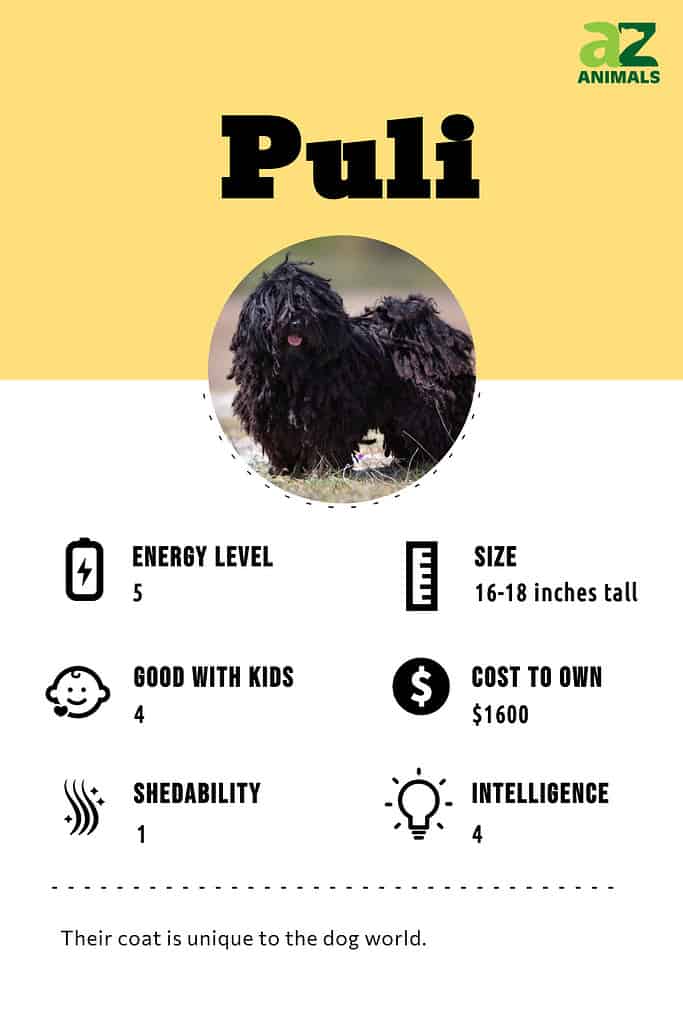
History Of The Breed
The Puli dog is considered to be of Hungarian origin, yet many books on this breed trace its history to ancient communities in Tibet, India, and western China. Turkic nomadic people from Central Asia, also known as Cumans, were believed to have brought the Puli to Hungary in the mid-13th Century, although there are archives that show this breed worked in Eastern Hungary, on the fields of Puszta, as far back as the 9th Century.
The Best Dog Food For Puli
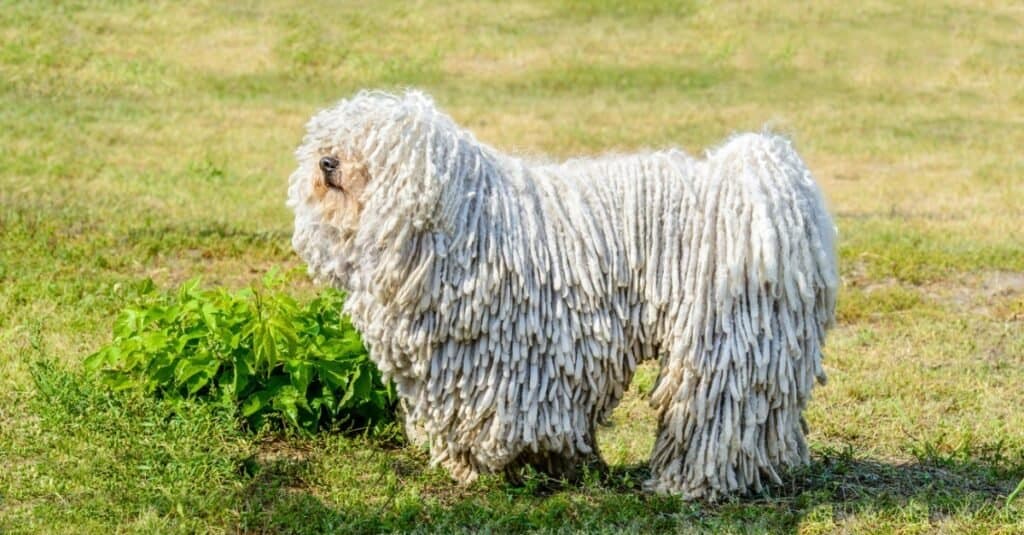
Puli diet should be age-appropriate to accommodate their needs.
©iStock.com/volofin
Pulik requires a diet of high-quality dog food, whether it’s commercially prepared or home-cooked, based on a veterinarian-approved recipe. Most U.S. dog food brands must meet the Association of American Feed Control Officials (AAFCO) standards, and you should only feed your dog a brand that has been approved.
The Puli’s diet should be age-appropriate, with kibble or recipes designed to accommodate their needs in the puppy, adult, or senior dog life phases. These dogs can be prone to weight gain, particularly without proper exercise, so supervise your dog’s calorie consumption and track their weight if needed. A formula consisting primarily of high-grade, animal-sourced protein and complemented with great vitamins and minerals will make for a happy, healthy pup.
At A-Z Animals, we recommend Taste of the Wild’s Pacific Stream Smoked Salmon dry food, which contains real salmon as the primary ingredient, full of protein and omega-3 fatty acids. This recipe also features vitamins and minerals from fruits and superfoods to promote joint health, encourage a glossy coat, and provide your puli with the energy it needs.
3 Pros And Cons Of Owning A Puli
| Pros! | Cons! |
| Highly intelligent and easily trainable The puli’s intelligence makes it easy to train and eager to please. | Loud barker A vigilant watchdog, your pup will immediately let you know about newcomers. |
| Exceedingly loyal The dog will never want to leave your size. | Independent with herding instincts Without proper leadership, puli can go rogue and refuse to listen to commands if it thinks it knows best. |
| Healthy with low medical maintenance Pulik are a generally healthy breed with few genetic health concerns. | High-maintenance grooming needs These dogs require extensive grooming care due to their cords. |
Size And Weight
Female pulis are compact, reaching heights between 14 and 16 inches, while males reach up to 18 inches. Full-grown puli males can weigh 30-35 pounds, and females reach between 25 and 30 pounds.
| Height (Male) | 18’ Tall |
| Height (Female) | 16’ Tall |
| Weight (male) | 35 bs, fully grown |
| Weight (female) | 30 lbs, fully grown |
Common Health Issues
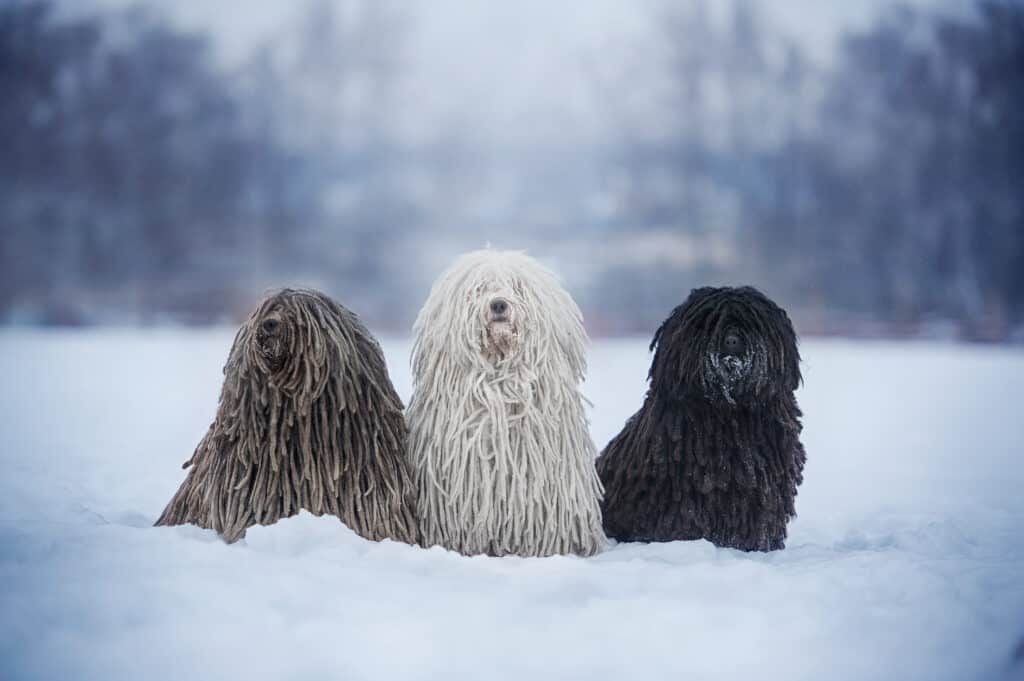
Pulik are generally healthy dogs with few inherited conditions.
©BORINA OLGA/Shutterstock.com
Pulik are generally healthy dogs with few genetically inherited conditions. However, reputable breeders will test their breeding pups for common health issues across different types of dogs. Per Puli Club of America guidelines, dog breeders should test to confirm their dogs are free from conditions such as hip dysplasia, patella, degenerative myelopathy, and eye tests. Additional cardiac, thyroid, and hearing tests are common but not universal among breeders.
When considering a puli, be sure to ask any potential breeder about what conditions they test and other questions related to the temperament and health of a dog’s parents.
Temperament
The puli is brilliant and high-energy, requiring enough exercise to discharge all the mental and physical energy packed into its medium-sized form. With proper exercise and disciplined training, a puli can live in the city. However, they prefer to live in outdoor environments, such as an enclosed property or agricultural land, where they can access the type of exercise for which they were bred.
Pulik are very cozy and love cuddling with children and their family members. However, they are sensitive dogs that don’t do well with adverse treatment – they may resent their owners if not given proper care.
How To Take Care Of Puli

Puli dogs’ natural dreadlocks are instantly recognizable, wooly and dense, and nearly entirely waterproof, bred to protect them from brutal European winters.
©iStock.com/volofin
Pulik are headstrong and high-maintenance pups with many requirements in grooming, training, and exercise. However, to those willing to do the work, the puli provides plenty of affection and loyalty, making for loving and loyal protectors of their “herd.”
Maintenance And Grooming
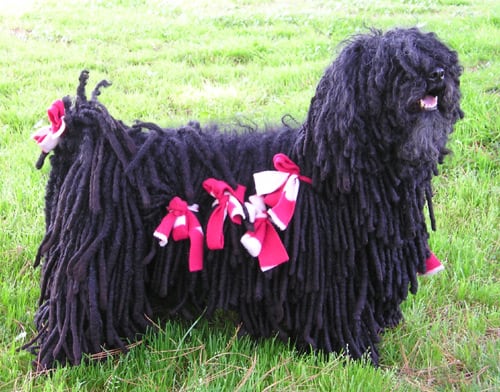
Puli coats require consistent care.
©Elf at en.wikipedia, CC BY-SA 3.0 <http://creativecommons.org/licenses/by-sa/3.0/>, via Wikimedia Commons – License
The puli coat is the main focus of any dedicated owner and requires consistent care, whether corded, clipped, or brushed. Puli coats require simple bathing until they reach ten months of age when their undercoat starts to develop. As the dog matures, the coats grow thicker and mat to the touch. Natural separations occur in the fur as it clumps together close to the skin – these are the beginnings of the cording process. The hair lengthens, and the owner should manually separate the cords into soft clumps by organizing them and pulling them apart with your fingers.
This process requires repetition over six to nine months until your puli reaches two years of age. Be sure to properly introduce your dog to hair treatment with plenty of positive reinforcement and affection, and your pup will come to associate the task with appreciation. Once the cords are formed, include clipping and regular maintenance as part of a routine that includes nail trimming, ear cleaning, and checking for debris in the coat and behind the ears.
Training
Pulik need loads of training and mental stimulation to live happy, healthy lives. These dogs are brilliant, able to learn tricks quickly, and eager to please their owners. However, if you don’t display clear leadership and a consistent set of rules, pulis will have no problem ignoring commands. Herding dogs are loathe to easily give up control and don’t care for repetition, so owners will need to provide structure and clear rules and establish themselves as alpha to maintain their puli’s respect. Early training in puppyhood and socialization will go a long way to earning your pup’s loyalty.
Exercise
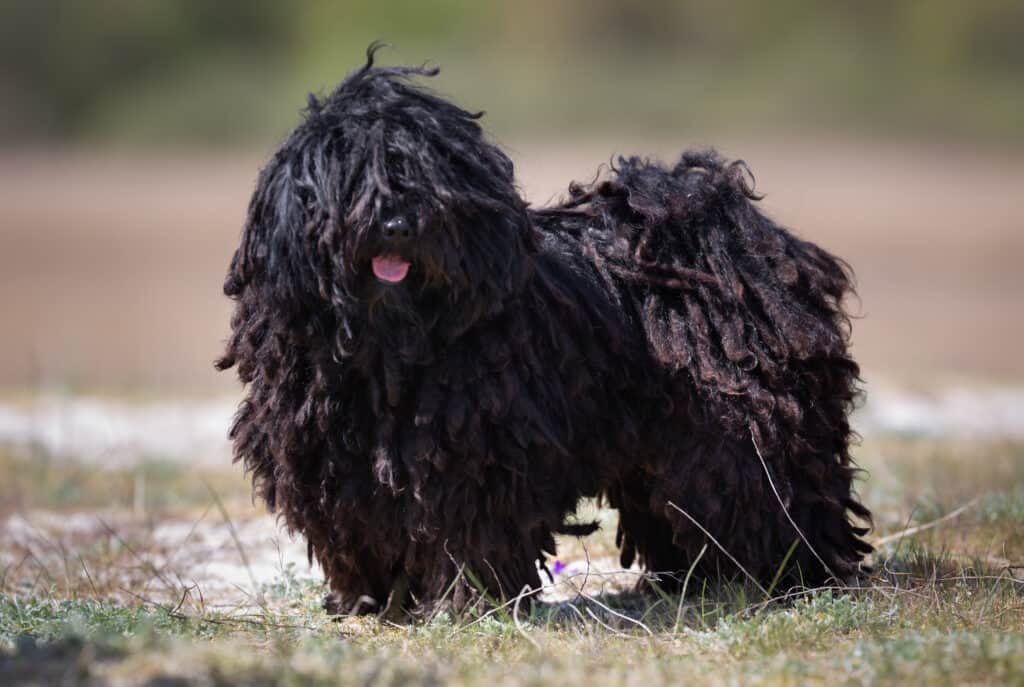
Pulik dogs require at least 60 minutes of daily exercise.
©iStock.com/Bigandt_Photography
Pulik are high-intensity dogs that thrive on physical exercise. Breeders will caution owners not to overdo it on sports to keep joints healthy. Despite this, pulik thrive at sports, including obedience training, herding, agility, and other speed-related activities. In daily life, the puli requires at least an hour of exercise daily, usually in the form of multiple walks or free play in an open backyard.
Puppies
As the new owner of a puli puppy, your primary job is to introduce him to as many new people, dogs, and puppies as possible in a positive manner. After completing all necessary vaccines, expose your dog to friend visits, car rides, and even puppy school to associate meeting new experiences with positivity and fun. All new meetings should be enjoyable for your dog, and making your pup comfortable with new sounds, smells, and sights will help him develop into a confident, calmer puli.
Puli And Children
Pulik are extremely fond of children and will take the role of serving as companion and protector very seriously. They love guarding their charges and often will imprint on young children when raised together. A puli often forgives children’s rudeness but won’t tolerate extreme violations or pushing around. As such, it’s essential to supervise kid-puli playtime and teach your child to respect dogs properly.
Dogs Similar To Puli
The Puli is closely related to other corded sheepdogs and herders, such as Komondors, Croatian sheepdogs, and the Bergamasco sheepdog.
- Komondor: Komondors are another corded dog that requires just as intense grooming.
- Croatian sheepdog: Croatian sheepdogs are nimble, agile dogs with a natural herding ability similar to pulik.
- Bergamasco sheepdog: Bergamascos are another variety of sheepdog bred originally in modern-day Iran.
Popular Names For Puli
Popular names for Puli dogs include:
- Lazlo
- Beast
- Henry
- Alma
- Pepper
- Luna
Puli FAQs (Frequently Asked Questions)
What is the lifespan of a Puli?
The average lifespan of a puli ranges from 11 to 14 years, though they retain the puppy-like characteristics well into older age.
Are Puli’s hypoallergenic?
Despite their long cords, pulik are hypoallergenic dogs that hardly drool or shed. However, they require plenty of grooming to keep their coats in shape.
How much do Puli dogs cost?
When adopted, puli pups cost around $300 to cover first-day expenses and to ensure they go to a happy home. From a breeder, puppies can cost as much as $1,600, depending on their lineage and club registrations.
Thank you for reading! Have some feedback for us? Contact the AZ Animals editorial team.
Sources
- American Kennel Club, Available here: https://www.akc.org/dog-breeds/puli/
- Puli Club of America, Available here: https://www.puliclub.org/wp/
- Encyclopedia Brittanica, Available here: https://www.britannica.com/animal/puli
- German Puli Club, Available here: https://www.puli.de/en/
- Hungarian Puli Club of Great Britain, Available here: https://www.hungarianpuliclubofgb.co.uk/about-pulis/puli-coat-care-an-article-written-by-jennifer-whitton/

